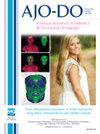下颌切牙内收和不内收后的下唇变化。
IF 3
2区 医学
Q1 DENTISTRY, ORAL SURGERY & MEDICINE
American Journal of Orthodontics and Dentofacial Orthopedics
Pub Date : 2025-06-01
DOI:10.1016/j.ajodo.2024.12.011
引用次数: 0
摘要
介绍:4颗(2颗上颌+ 2颗下颌骨)前磨牙(4P)和2颗上颌前磨牙(U4)拔除通常用于II类错颌过度覆盖。虽然上唇的变化已被广泛研究,但下唇的变化仍不清楚。观察上颌和下颌切牙运动后的软组织反应。方法:将90张治疗前后侧位头片进行数字化处理,根据初始覆盖和治疗情况分为正常覆盖4P组(NJ-4P)、过度覆盖4P组(EJ-4P)、过度覆盖U4组(EJ-U4),每组30张。比较头侧测量参数,并测定唇-切牙变化比(上唇-上颌切牙、下唇-下颌切牙、下唇-上颌切牙)。结果:上、下唇位置、颏唇面积、朱唇厚度等软组织参数变化显著。NJ-4P/ ejj - u4与NJ-4P/ ejj - u4对下唇-下颌切牙比例、NJ-4P/ ejj - u4与NJ-4P/ ejj - 4p对下唇-上颌切牙比例差异均有统计学意义,但对上唇-上颌切牙比例差异无统计学意义。结论:上颌切牙和下颚切牙牵出后,过度覆盖和骨骼ⅱ类错牙合患者在进行4P拔除后,其上唇突出的减少幅度小于正常覆盖者,下唇突出的减少幅度大于正常覆盖者。此外,在接受U4拔牙的患者中,下唇突出的减少可以通过最小的下颌门牙内缩来实现。临床检查时应注意上颌切牙对下唇的潜在影响,特别是在过度溢位错牙合时。本文章由计算机程序翻译,如有差异,请以英文原文为准。
Lower lip changes after overjet reduction with and without mandibular incisor retraction
Introduction
Four (2 maxillary + 2 mandibular) premolar (4P) and 2 maxillary premolar (U4) extractions are commonly employed for Class II malocclusion with excessive overjet. Although upper lip changes have been widely investigated, lower lip changes remain unclear. The soft-tissue responses after maxillary and mandibular incisor movements in each protocol were investigated.
Methods
A total of 90 pretreatment and posttreatment lateral cephalograms were digitized and allocated to 3 groups (n = 30 each) according to the initial overjet and treatment: normal overjet with 4P (NJ-4P), excessive overjet with 4P (EJ-4P), and excessive overjet with U4 (EJ-U4). The cephalometric parameters were compared, and the lip-to-incisor change ratios (upper lip–maxillary incisor, lower lip–mandibular incisor, and lower lip–maxillary incisor) were determined.
Results
Soft-tissue parameters revealing significant changes among the groups included upper lip and lower lip positions, mentolabial area, and vermilion lip thickness. Significant differences were observed between NJ-4P/EJ-U4 for lower lip–mandibular incisor ratio and between NJ-4P/EJ-U4 and NJ-4P/EJ-4P for lower lip–maxillary incisor ratio but not for upper lip–maxillary incisor ratio.
Conclusions
Reduction in upper lip protrusion was smaller, whereas that in lower lip protrusion was greater after maxillary incisor and mandibular incisor retraction, respectively, in patients with excessive overjet and skeletal Class II malocclusion undergoing the 4P extraction than in those with normal overjet. Moreover, a reduction in lower lip protrusion can be expected with minimal retraction of the mandibular incisors in patients undergoing U4 extraction. The potential impact of the maxillary incisors on the lower lip, especially in excessive overjet malocclusion, should be noted during clinical examination.
求助全文
通过发布文献求助,成功后即可免费获取论文全文。
去求助
来源期刊
CiteScore
4.80
自引率
13.30%
发文量
432
审稿时长
66 days
期刊介绍:
Published for more than 100 years, the American Journal of Orthodontics and Dentofacial Orthopedics remains the leading orthodontic resource. It is the official publication of the American Association of Orthodontists, its constituent societies, the American Board of Orthodontics, and the College of Diplomates of the American Board of Orthodontics. Each month its readers have access to original peer-reviewed articles that examine all phases of orthodontic treatment. Illustrated throughout, the publication includes tables, color photographs, and statistical data. Coverage includes successful diagnostic procedures, imaging techniques, bracket and archwire materials, extraction and impaction concerns, orthognathic surgery, TMJ disorders, removable appliances, and adult therapy.

 求助内容:
求助内容: 应助结果提醒方式:
应助结果提醒方式:


